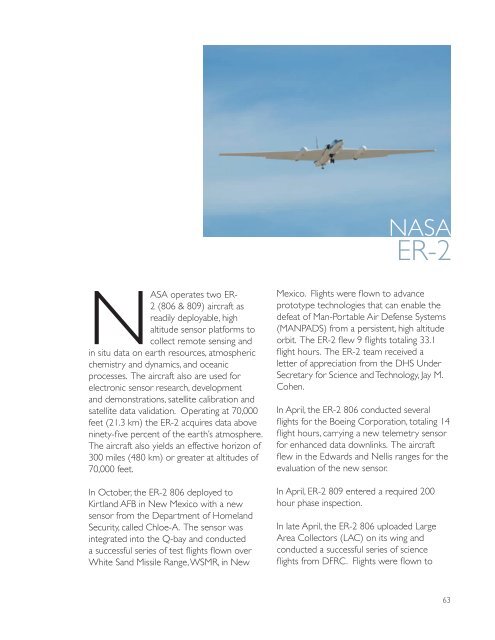2008 Annual Report - NASA Airborne Science Program
2008 Annual Report - NASA Airborne Science Program
2008 Annual Report - NASA Airborne Science Program
You also want an ePaper? Increase the reach of your titles
YUMPU automatically turns print PDFs into web optimized ePapers that Google loves.
<strong>NASA</strong><br />
ER-2<br />
<strong>NASA</strong> operates two ER-<br />
2 (806 & 809) aircraft as<br />
readily deployable, high<br />
altitude sensor platforms to<br />
collect remote sensing and<br />
in situ data on earth resources, atmospheric<br />
chemistry and dynamics, and oceanic<br />
processes. The aircraft also are used for<br />
electronic sensor research, development<br />
and demonstrations, satellite calibration and<br />
satellite data validation. Operating at 70,000<br />
feet (21.3 km) the ER-2 acquires data above<br />
ninety-five percent of the earth’s atmosphere.<br />
The aircraft also yields an effective horizon of<br />
300 miles (480 km) or greater at altitudes of<br />
70,000 feet.<br />
In October, the ER-2 806 deployed to<br />
Kirtland AFB in New Mexico with a new<br />
sensor from the Department of Homeland<br />
Security, called Chloe-A. The sensor was<br />
integrated into the Q-bay and conducted<br />
a successful series of test flights flown over<br />
White Sand Missile Range, WSMR, in New<br />
Mexico. Flights were flown to advance<br />
prototype technologies that can enable the<br />
defeat of Man-Portable Air Defense Systems<br />
(MANPADS) from a persistent, high altitude<br />
orbit. The ER-2 flew 9 flights totaling 33.1<br />
flight hours. The ER-2 team received a<br />
letter of appreciation from the DHS Under<br />
Secretary for <strong>Science</strong> and Technology, Jay M.<br />
Cohen.<br />
In April, the ER-2 806 conducted several<br />
flights for the Boeing Corporation, totaling 14<br />
flight hours, carrying a new telemetry sensor<br />
for enhanced data downlinks. The aircraft<br />
flew in the Edwards and Nellis ranges for the<br />
evaluation of the new sensor.<br />
In April, ER-2 809 entered a required 200<br />
hour phase inspection.<br />
In late April, the ER-2 806 uploaded Large<br />
Area Collectors (LAC) on its wing and<br />
conducted a successful series of science<br />
flights from DFRC. Flights were flown to<br />
63











